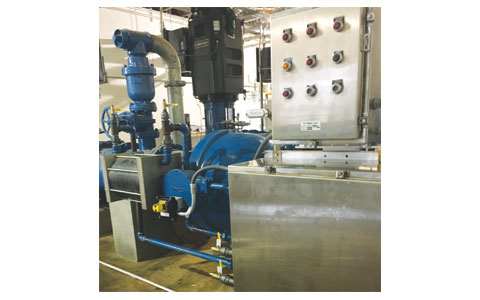posted on December 25, 2018 18:09

Water pumping systems that include a full-port ball valve for control save a significant amount of electrical energy given the negligible head loss of the ball valve. Also, when equipped with a smart control system, the pumping system is automatically protected from adverse operating conditions.
The ball valve will provide significant energy savings over the life of the plant. Most of the energy used at water plants is consumed for high service pumping costs to overcome the static head and friction losses of distribution systems. Headloss can be converted into an energy cost related to the pumping electricity needed to overcome the additional headloss from the valve using the equation:
A = (1.65 Q ΔH Sg C U) / E (1)
Where:
A = annual energy cost, dollars per year
Q = flow rate, gpm
ΔH = head loss, ft. of water
Sg = specific gravity, dimensionless (water = 1.0)
C = cost of electricity, $/kW·h
U = usage, percent x 100 (1.0 equals 24 hr per day)
E = efficiency of pump and motor set (0.80 typical)
The energy consumption difference between two valve selections can be calculated by using the headloss difference between the two valves for the variable ΔH in the equation above. For example, the difference in headloss between a 20-inch ball valve and 20-inch swing check valve operating at 10 ft/sec is approximately 2.5 feet of head (2). Therefore, assuming the pumps run 50% of the time with an efficiency of 80% and an electrical cost of $0.08 per kW-hr for 40 years.
TOTAL COST = 40 (1.65 x 9792 x 2.50 x 1.0 x 0.08 x 0.5) / (0.8)
TOTAL COST = $ 80,800 over 40 years per valve
The calculation shows that the use of a 20-in. AWWA ball valve in the place of a swing check valve can save $80,800 per valve over the life of the plant. It is clear that valve selection can play an important role in energy savings. Moreover, saving electrical energy also reduces the need for burning fossil fuels and creating greenhouse gases GHGs. On a national average, for every kW-hr of electricity used, about 1.14 pounds of CO2 emissions are generated. So in the example above, the use of a ball valve instead of a swing check valve would result in savings of 575 tons of CO2 emissions per valve over the 40-year life of the system.
The ball valve performs the critical function of an automatic check valve and is powered by an oil-powered cylinder actuator built in accordance to AWWA C541, which requires specific materials of construction and production test to assure a high level of quality and dependability. The valve’s hydraulic actuator is controlled by an oil-hydraulic control system containing solenoid valves and field-adjustable flow control valves. A smart electrical control panel is mounted on top of the hydraulic panel and provides the interface between the hydraulic system and the pump’s drive control unit. The electrical panel displays pump system operation, valve position, and alarm indications. In general the ball valve operates like a check valve, but it does so in slow motion and with no slam.
The smart electrical panel has three independent safety modes to monitor the pumping system. Upon receipt of a pump “Start” signal, the pump discharge is monitored by an adjustable pressure switch mounted on the discharge of the pipe. If the pump does not reach normal operating pressure within an adjustable time period of 1-10 minutes, a safety circuit will close the ball valve, provide a “Emergency Stop” signal, and lock out the system until a reset button is pressed. There is a second safety mode that similarly shuts down the system if the pump runs at a set high pressure for an extended period, which may be a result of a downstream closed valve. Finally, if the pump discharge pressure drops too low for an extended time period, a similar safety mode is triggered. The smart panel is wired to the pump control drive for remote monitoring of conditions and helps protect the pumping system from abnormal operating conditions.
Technological advances related to pump control valves provide a significant contribution to pumping system performance and energy savings. The AWWA ball valve provides low headloss and equal percentage flow characteristics to eliminate check valve slam and prevent system pressure surges. Ball valve hydraulic and electric control panels provide reliable operation, field adjustability, and smart monitoring of system operation.
For a description of an actual installation refer to our white paper.
Author: Val-Matic